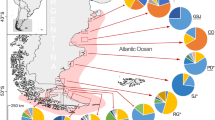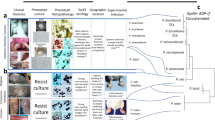Abstract
A morphobiometrical and molecular study of two populations of Demodex folliculorum from humans isolated from different habitats, skin and eyelashes follicles, were carried out. Morphological and biometrical studies revealed two closely related populations with any distinctive characteristics. For molecular study, a 436-bp region of the 16S rDNA gene and a 453-bp region of the cytochrome oxidase I (COI) gene from individual mites of each population considered were sequenced. Intraindividual and interindividual sequence variation was studied in both populations. Our data show that 16S rDNA is not a useful marker to discriminate between populations; however, COI gene sequences can help to identify the two populations considered, which are morphologically very close and difficult to separate by classic methods. These results are in agreement with the morphological and biometrical differences detected between D. folliculorum from eyelashes and human skin. This study appeals for the revision of the taxonomic status of the D. folliculorum populations, as well as for the species included within genus Demodex.



Similar content being viewed by others
References
Alasaad S, Soglia D, Sarasa M, Soriguer RC, Pérez JM, Granados JE, Rasero R, Zhu XQ, Rossi L (2008) Skin-scale genetic structure of Sarcoptes scabiei populations from individual hosts: empirical evidence from Iberian ibex-derived mites. Parasitol Res 104(1):101–105
Black WC IV, Piesman J (1994) Phylogeny of hard and soft-tick taxa (Acari: Ixodida) based on mitochondrial 16S rDNA sequences. Proc Natl Acad Sci 91(21):10034–10038
Caporale DA, Rich SM, Spielman A, Telford SR III, Kocher TD (1995) Discriminating between Ixodes ticks by means of mitochondrial DNA sequences. Mol Phylogenet Evol 4(4):361–365
Clifford CW, Fulk GW (1990) Association of diabetes, lash loss, and Staphylococcus aureus with infestation of eyelids by Demodex folliculorum (Acari: Demodicidae). J Med Entomol 27(4):467–470
Corredor-Osorio R, Nava CA, Tovilla CJL, Tovilla PJL, Muñoz SS (2000) Blefaritis por Demodex folliculorum. Rev Fac Med UNAM 43(4)
Coston TO (1967) Demodex folliculorum blepharitis. Trans Am Ophthalmol Soc 65:361–392
de Rojas M, Mora MD, Ubeda JM, Cutillas C, Navajas M, Guevara DC (2001) Phylogenetic relationships in rhinonyssid mites (Acari: Rhinonyssidae) based on mitochondrial 16S rDNA sequences. Exp Appl Acarol 25:957–967
de Rojas M, Mora MD, Ubeda JM, Cutillas C, Navajas M, Guevara DC (2002) Phylogenetic relationships in rhinonyssid mites (Acari: Rhinonyssidae) based on ribosomal DNA sequences: insights for the discrimination of closely related species. Parasitol Res 88(7):675–681
de Rojas M, Ubeda JM, Cutillas C, Mora MD, Ariza C, Guevara DC (2007) Utility of ITS1-5.8S-ITS2 and 16S mitochondrial DNA sequences for species identification and phylogenetic inference within the Rhinonyssus coniventris species complex (Acari: Rhinonyssidae). Parasitol Res 100(5):1041–1046
Desch CE, Hillier A (2003) Demodex injai: a new species of hair follicle mite (Acari: Demodicidae) from the domestic dog (Canidae). Entomol Soc Am 40(2):146–149
Desch C, Nutting WB (1972) Demodex folliculorum (Simon) and D. brevis Akbulatova of man: redescription and reevaluation. J Parasitol 58:169–177
Desch CE Jr, Stewart TB (1999) Demodex gatoi: new species of hair follicle mite (Acari: Demodicidae) from the domestic cat (Carnivora: Felidae). Entomol Soc Am 36(2):167–170
Dolenc-Volje M, Pohar M, Lunder T (2005) Density of Demodex folliculorum in perioral dermatitis. Acta Derm Venereol 85:211–215
Elston DM (2005) Demodex mites as a cause of human disease. Cutis 76(5):294–296
Elston DM (2010) Demodex mites: facts and controversies. Clin Dermatol 28:502–504
English FP, Nutting WB (1981) Demodicosis of ophthalmic concern. Am J Ophtalmol 91:362–372
Guglielmone AA, Venzal JM, Gonzalez-Acuña D, Nava S, Hinojosa A, Mangold AJ (2006) The phylogenetic position of Ixodes stilesi Neumann, 1911 (Acari: Ixodidae): morphological and preliminary molecular evidences from 16S rDNA sequences. Syst Parasitol 65(1):1–11
Gutgesell VJ, Stern GA, Hood CL (1982) Histopatology of meibonian gland dysfunction. Am J Ophtalmol 94:383–387
Gylfe A, Yabuki M, Drotz M, Bergström S, Fukunaga M, Olsen B (2001) Phylogeographic relationships of Ixodes uriae (Acari: Ixodidae) and their significance to transequatorial dispersal of Borrelia garinii. Hereditas 134(3):195–199
Hirst S (1919) Studies on Acari. no 1. The genus Demodex Owen. London, Br Mus Nat Hist. p 44
Jing X, Shulin G, Ying L (2005) Enviromental scanning electron microscopy observation of the ultrastructure of Demodex. Microsc Res Tech 68:284–289
Kligman AM, Christensen MS (2011) Demodex folliculorum: requirements for understanding its role in human skin disease. J Invest Dermatol 131:8–10
Lacey N, Ni Raghallaigh S, Powell FC (2011) Demodex mites−Commensals, parasites or mutualistic organisms? Dermatology 11:1–4
Mangold AJ, Bargues MD, Mas-Coma S (1998) Mitochondrial 16S rDNA sequences and phylogenetic relationships of species of Rhipicephalus and other tick genera among Metrastiata (Acari: Ixodidae). Parasitol Res 84(6):478–484
Mitani H, Takahashi M, Masuyama M, Fukunaga M (2007) Ixodes philipi (Acari: Ixodidae): phylogenetic status inferred from mitochondrial cytochrome oxidase subunit I gene sequence comparison. J Parasitol 93(3):719–722
Navajas M, Gutierrez J, Bonato HR, Mapangou-Divassa S (1994) Intraspecific diversity of the Cassava green mite Mononychellus progresivus (Acari: Tetranychidae) using comparisons of mitochondrial and nuclear ribosomal DNA sequences and cross-breeding. Exp Appl Acarol 18(6):651–660
Navajas M, Fournier D, Lagnel J, Gutierrez J, Boursot P (1996) Mitochondrial COI sequences in mites: evidence for variations in base composition. Insect Mol Biol 5(4):281–285
Navajas M, Gutierrez J, Gotoh T (1997) Convergence of molecular and morphological data reveals phylogenetic information on Tetranychus species and allows the restoration of the genus Amphitetranychus (Acari: Tetranychidae). Bull Entomol Res 87:283–288
Navajas M, Lagnel J, Gutierrez J, Boursot P (1998) Species-wide homogeneity of nuclear ribosomal ITS2 sequences in the spider mite Tetranychus urticae contrasts with extensive mitochondrial COI polymorphism. Heredity 80:742–752
Navia D, de Moraes GJ, Roderick G, Navajas M (2005) The invasive coconut mite Aceria guerreronis (Acari: Eriophyidae): origin and invasion sources inferred from mitochondrial (16S) and nuclear (ITS) sequences. Bull Entomol Res 95(6):505–516
Rich SM, Caporale DA, Telford SR III, Kocher TD, Kartl DL, Spielman A (1995) Distribution of Ixodes ricinus-like ticks of eastern North America. Proc Natl Acad Sci 92:6284–6288
Rodríguez H (2000) Prevalencia de Demodex sp. en pacientes con blefaritis. Ann Fac Med 61(4):299–304
Rufli T, Mumcuoglu Y (1981) The hair follicle mites Demodex folliculorum and Demodex brevis: biology and medical importance. A review. Dermatology 162(1):1–11
Simon C, Frati F, Beckenbach AT et al (1994) Evolution, weighting and phylogenetic utility of mitochondrial gene sequences and a compilation of conserved polymerase chain reaction primers. Entomol Soc Am 87:651–701
Thompson JD, Higgins DG, Gibson TJ (1994) CLUSTAL W: improving the sensitivity of progressive multiple sequence alignment through sequence weighting, positions-specific gap penalties and weight matrix choice. Nucleic Acc Res 22:4673–4680
Author information
Authors and Affiliations
Corresponding author
Rights and permissions
About this article
Cite this article
de Rojas, M., Riazzo, C., Callejón, R. et al. Morphobiometrical and molecular study of two populations of Demodex folliculorum from humans. Parasitol Res 110, 227–233 (2012). https://doi.org/10.1007/s00436-011-2476-3
Received:
Accepted:
Published:
Issue Date:
DOI: https://doi.org/10.1007/s00436-011-2476-3




